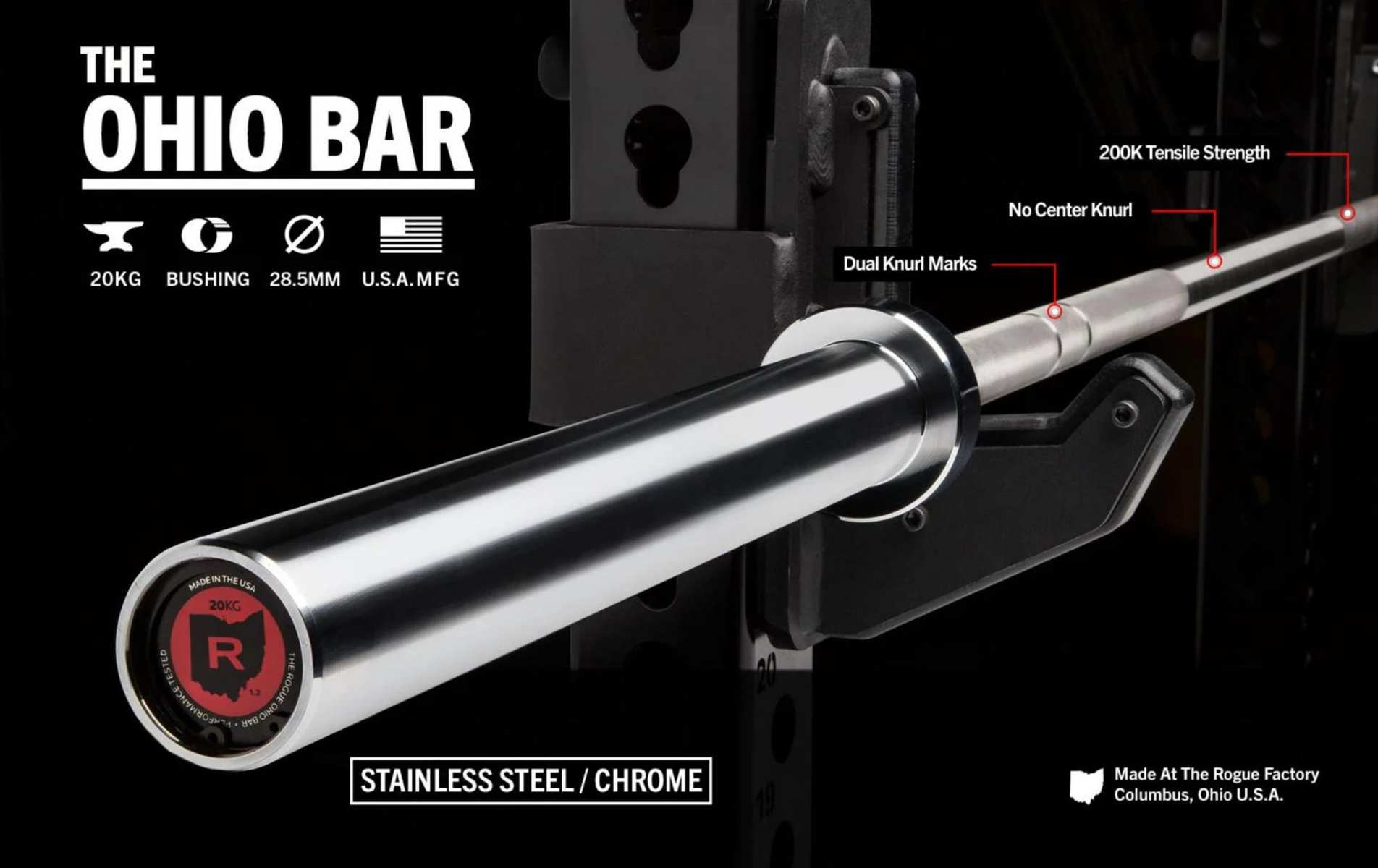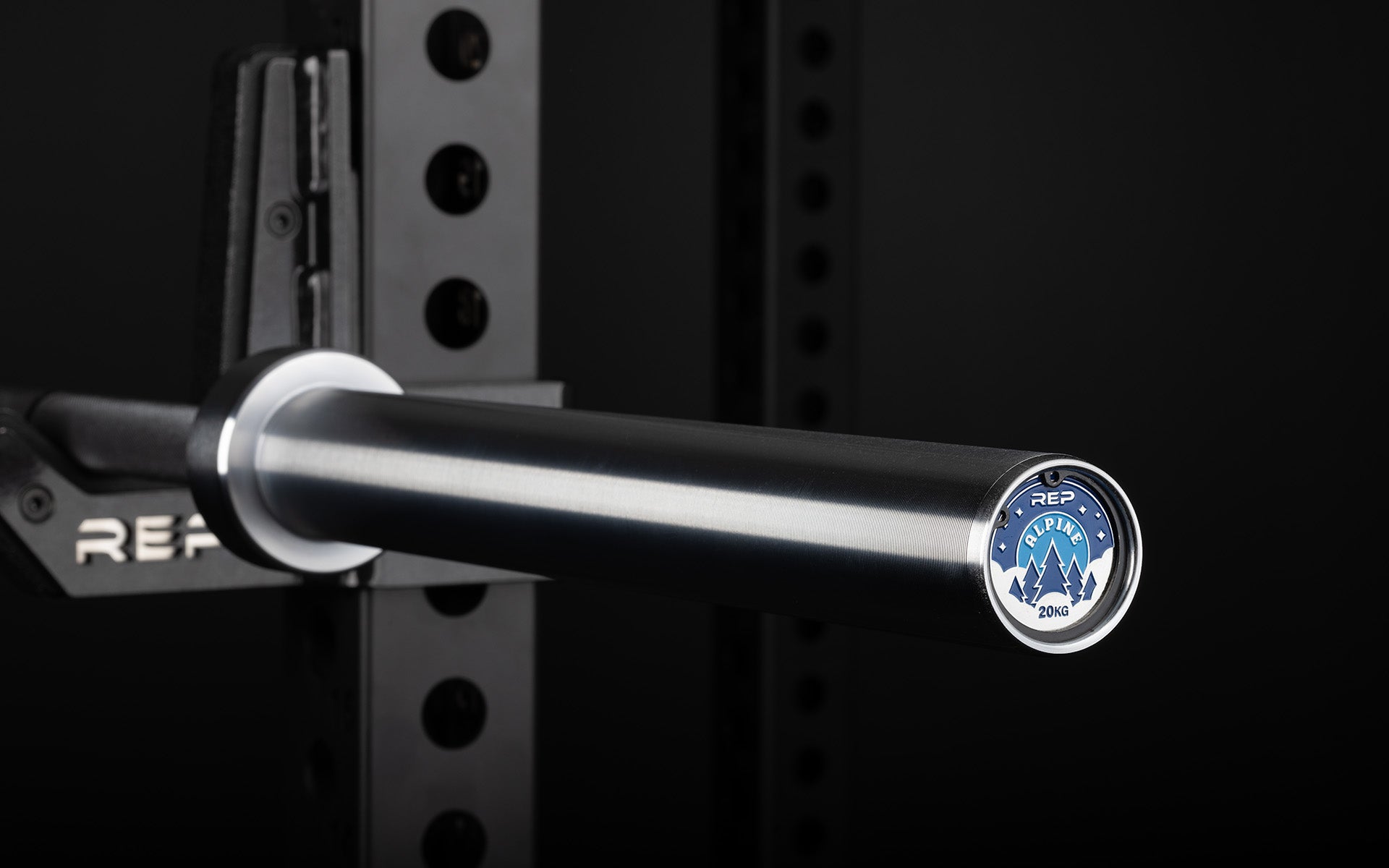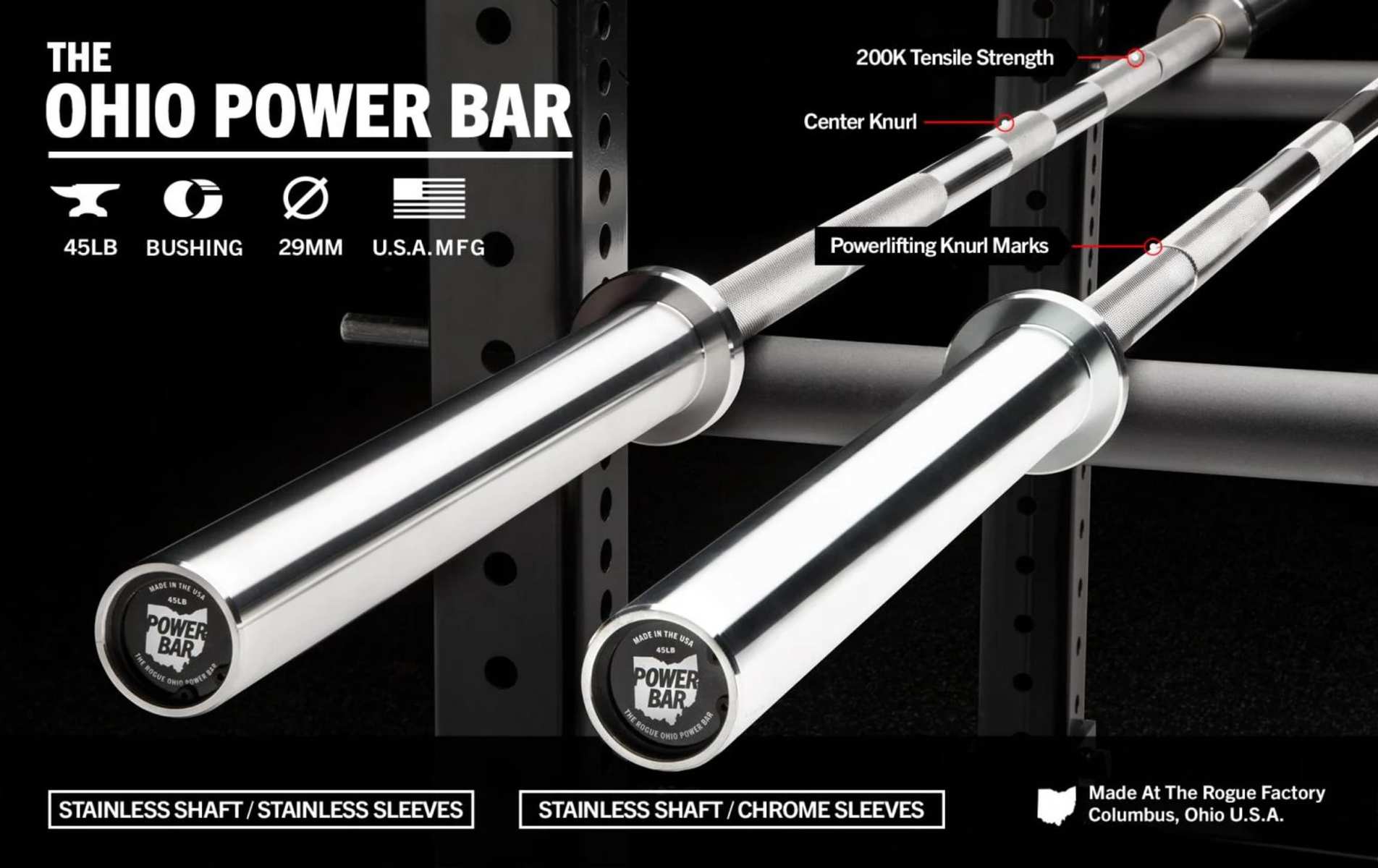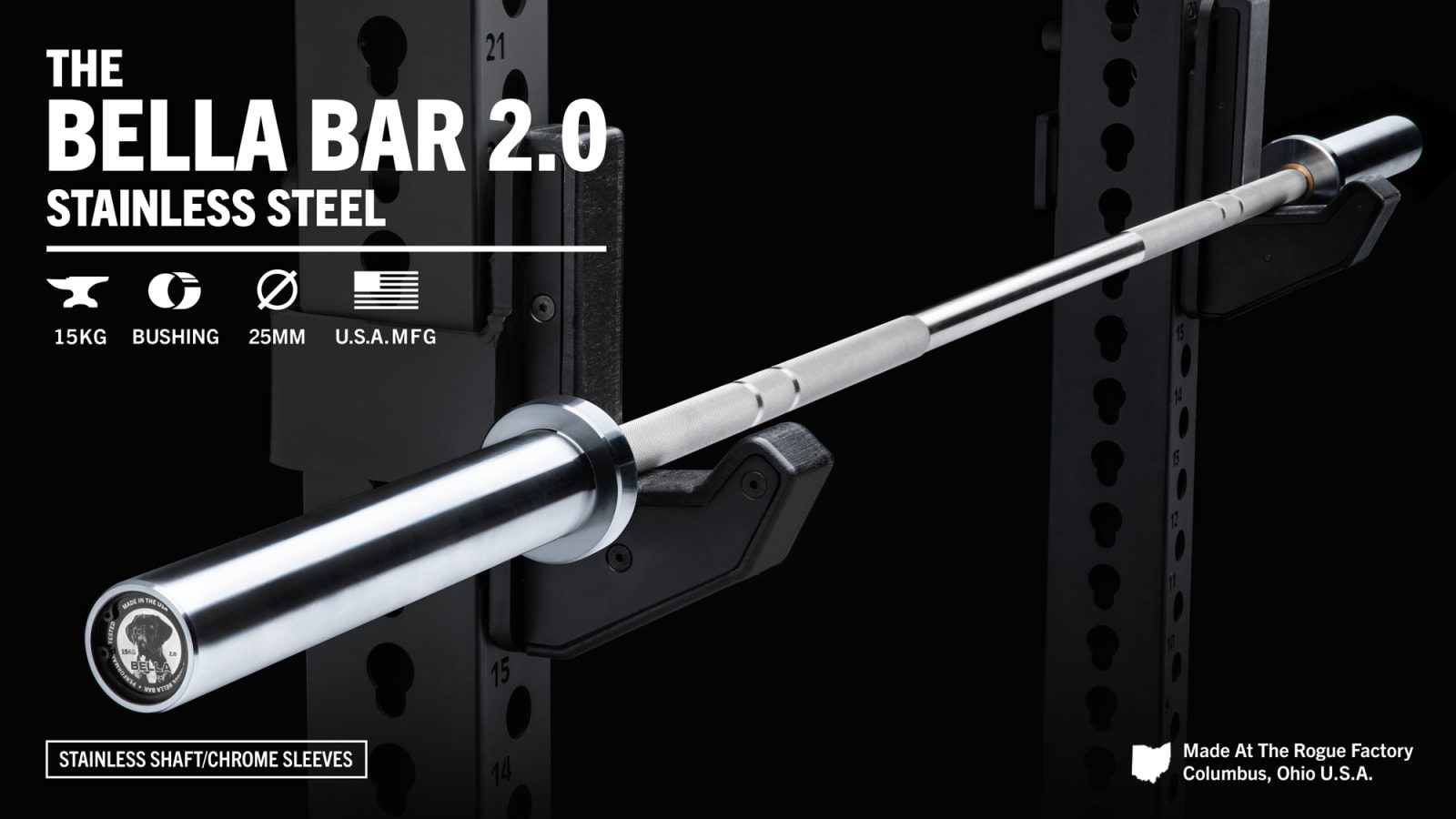Stepping into the world of weightlifting is not just about the reps, sets, or the weight you lift. It’s also about the equipment you choose, particularly the barbell.
As a home gym owner, you might often find yourself in a dilemma over which barbell to purchase. The market is teeming with various materials, colors, and finishes.
However, one material that has garnered immense popularity in recent years is stainless steel. But why?
It offers a blend of durability, corrosion resistance, and a natural feel that many weightlifting enthusiasts crave.
In this guide, we’ll delve deep into the best stainless steel barbells of 2024, breaking down their specs, advantages, and even their shortcomings.
Let’s get started!
On This Page
What Are The Best Stainless Steel Barbells?
- Best Overall – Rogue Ohio Bar Stainless Steel
- Best Olympic Barbell – American Barbell SS Precision Training Bar
- Best Value Olympic Barbell – Rep Alpine Weightlifting Bar
- Best Power Bar – American Barbell Elite Power Bar
- Best Value Power Bar – Rogue 45lb Ohio Power Bar – Stainless Steel
- Best Multipurpose Bar – Fringe Sport 20kg Wonder Bar Stainless Steel
- Best Women’s Bar – Rogue Bella Bar 2.0 – Stainless Steel
- Best Curl Bar – American Barbell Stainless Steel EZ Curl Gym Bar
- Best Value Curl Bar – Rep Rackable Curl Bar – Stainless Steel
Best Overall – Rogue Ohio Bar Stainless Steel
Specs
- Material – Stainless Steel
- Weight – 20kg (44lbs)
- Length – 86.75″ (7.2 ft)
- Shaft Diameter – 28.5mm
- Loadable Sleeve Length – 16.40″
- Tensile Strength – 200,000 PSI
- Knurl – Dual knurl marks optimized for both Olympic lifts and Powerlifting, with no center knurl.
- Rotation System – Bronze bushings ensure a reliable spin.
- Price – $465
- Warranty – Lifetime
Pros
Cons
Summary
The
Its versatility is evident, making it a top choice for both Powerlifting and Olympic lifting enthusiasts.
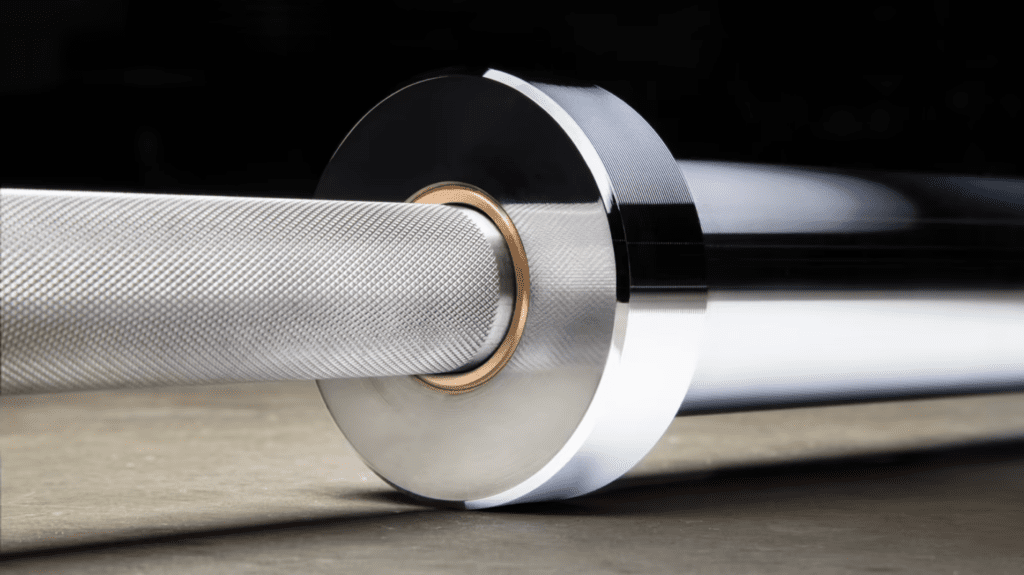
This adaptability extends from exercises like bench presses to deadlifts.
The bar’s knurling is masterfully designed, ensuring neither an overly passive nor aggressive grip, but rather a perfect balance that users find both comfortable and secure.
Another standout feature is its exceptional spin, facilitated by bronze bushings, which is especially critical for Olympic lifts.
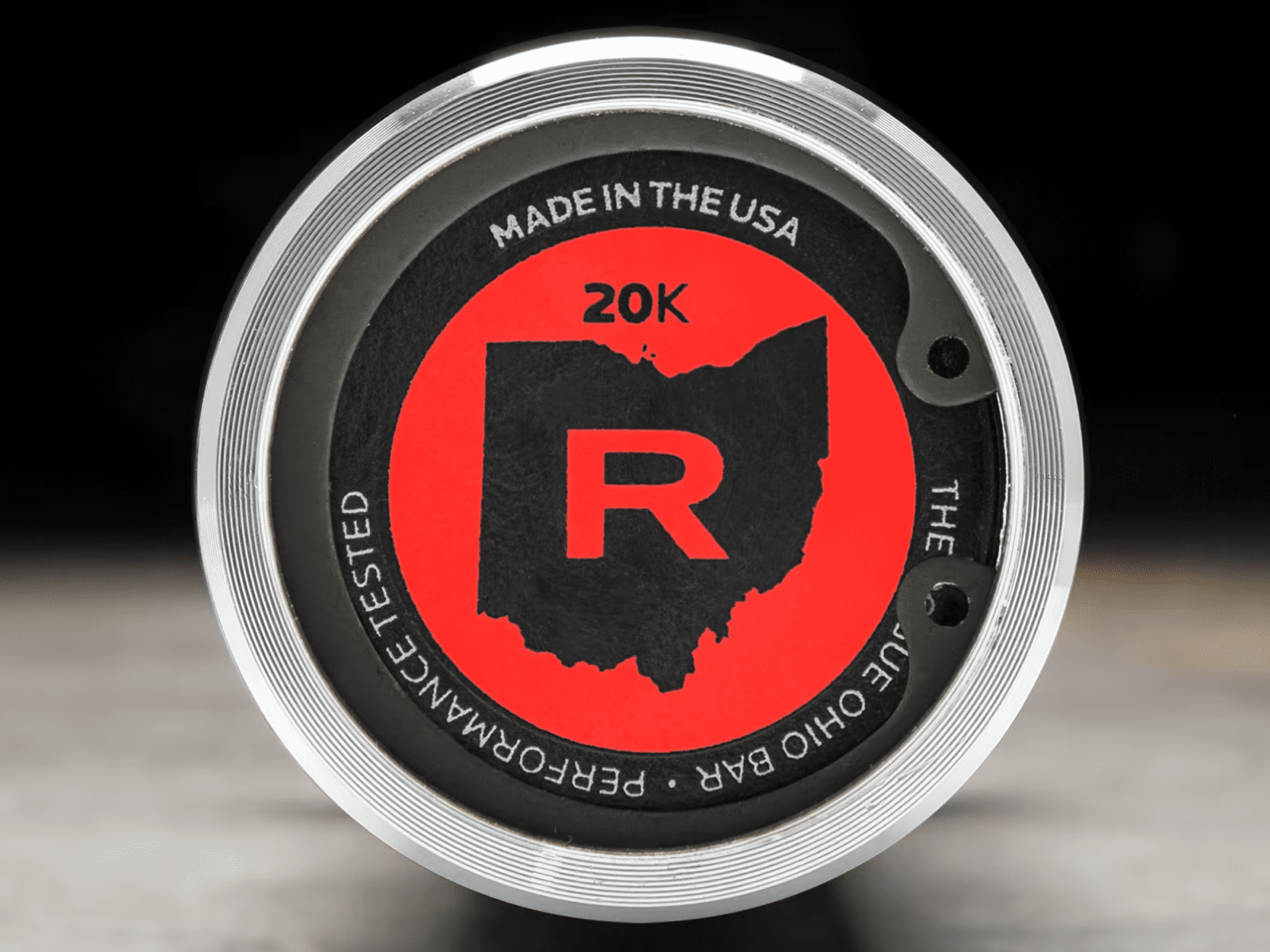
When it comes to aesthetics and durability,
The pristine stainless steel finish not only enhances its look but also promises longevity.
This durability claim is backed by users who’ve been loyal to the bar since 2017, emphasizing its consistent performance.

Its stainless steel nature ensures an authentic feel, offering a grip that’s both firm and non-abrasive.
For those setting up home gyms, especially in locations prone to moisture, its rust-resistant qualities and minimal maintenance requirements are a boon.
Moreover, users affirm that the bar genuinely meets, if not exceeds, its advertised features, from its impeccable knurling to the smooth spin.

However, perfection is elusive. A notable critique from some users is the lack of a center knurl, which is often preferred for exercises like back squats.
Additionally, while the bar’s quality is unquestionable, it does come with a premium price tag, currently pegged at $465.00, which may be a consideration for some.
In essence, the
Check out the best barbells in our comprehensive guide.
Best Olympic Barbell – American Barbell SS Precision Training Bar
Specs
- Material – Stainless Steel
- Weight – 20kg (44lbs)
- Length – Likely around 7.2 ft.
- Shaft Diameter – 28mm
- Tensile Strength – 190,000 PSI
- Knurl – Medium knurling tailored for Olympic weightlifting without central knurling.
- Rotation System – The bushing system ensures a consistent and reliable spin.
- Price – $595
- Warranty – Limited Lifetime Warranty
Pros
Cons
Summary
The American Barbell SS Precision Training Bar is an embodiment of what an Olympic barbell should represent.
With its precision design tailored for Olympic lifts and a unique stainless steel grip that many users find unparalleled, it’s clear why this barbell stands out.

The bar’s aesthetic appeal, combined with its functionality—be it the smooth spin or its quiet operation—makes it a top choice for many.
Its durability, further enhanced by its resistance to environmental factors, ensures it’s a long-term investment for serious lifters.
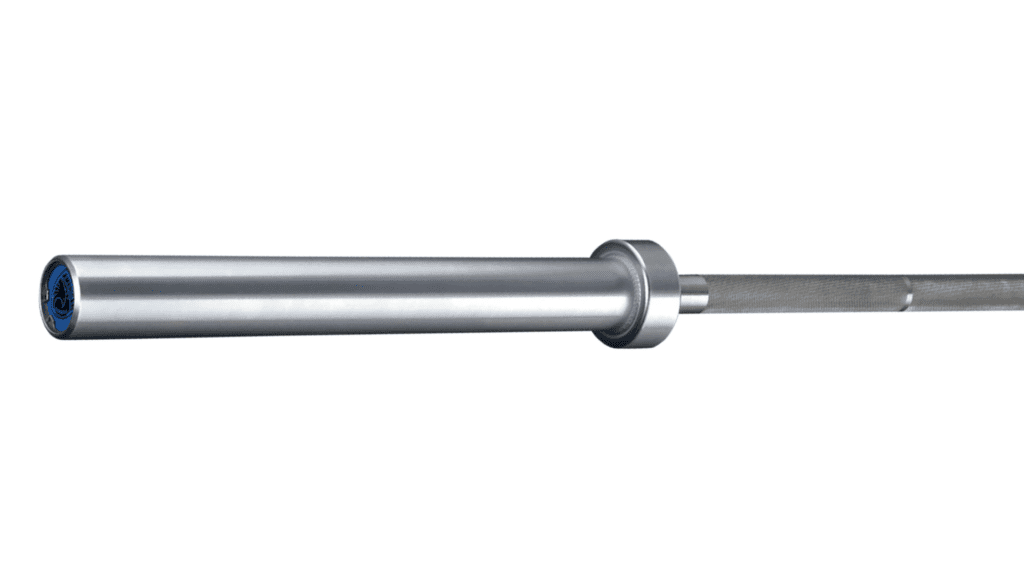
While some users have noted a slight rigidity, this is a subjective observation and might vary from person to person.
Considering its features and the overwhelmingly positive feedback, it’s evident that this barbell is worth its price point, serving as an excellent addition to any home gym or professional setup.
Check out more of the best weightlifting bars here.
Best Value Olympic Barbell – Rep Alpine Weightlifting Bar
Specs
- Material – Stainless Steel
- Weight – 20kg (44lbs)
- Length – 86.6″
- Shaft Diameter – 28mm
- Loadable Sleeve Length – 16.3″
- Sleeve Diameter – 50mm
- Rotation System – Hybrid Needle Bearings
- Sleeve Style – Ribbed
- Knurl Style – Volcano/Medium
- Center Knurl – Yes (Passive)
- Knurl Markings – IWF
- Shaft & Sleeve Coating – Stainless Steel
- Whip – Medium
- Static Rating – 1,500lbs
- Tensile Strength – 190k PSI
- Tolerance – 1%
Pros
Cons
Summary
Dive into a world where quality meets affordability with the Rep Alpine Weightlifting Bar.
Crafted meticulously for home gym owners, this top-tier Olympic weightlifting barbell is a testament to REP’s dedication to excellence.
With adherence to International Weightlifting Federation standards and a hybrid needle-bearing design, you’re assured of seamless lifts.
The medium-depth, volcano-style knurling guarantees an impeccable grip, ensuring your hands remain unscathed during intense sessions.
Plus, the array of finishes lets you choose a style that resonates with your personal aesthetic.
Some might yearn for a higher weight limit or a different knurling feel, but given its price point and features, the Rep Alpine Weightlifting Bar is undeniably a stellar addition to any home gym.
Best Power Bar – American Barbell Elite Power Bar
Specs
- Manufacturer – American Barbell
- Purpose – Powerlifting
- Bar Weight – 20kg
- Shaft Material – Stainless Steel
- Shaft Diameter – 29mm
- Sleeve Finish – Hard Chrome
- Rotation System – Bushing
- Tensile Strength – 190,000 PSI
- Knurl Type – Medium
- Center Knurl – Yes
- Knurl Marks – Powerlifting
- Warranty – Limited Lifetime
- Made In – USA
- Price – $595
Pros
Cons
Summary
The American Barbell Elite Power Bar epitomizes the fusion of design, quality, and performance.
Crafted in the USA, this barbell is tailored for powerlifters who refuse to compromise on quality.
With a stainless steel finish, it not only stands resilient against rust but also offers a distinctive raw grip that many home gym owners crave.
It’s medium knurling strikes the right balance between grip and comfort.
While its price tag might raise eyebrows, the chorus of positive reviews underscores its value.
A few concerns about the sleeve coating durability do exist, but they’re overshadowed by the bar’s overarching premium features.
If you’re looking to elevate your lifting game, the American Barbell Elite Power Bar is a worthy contender to consider.
Learn more about the best powerlifting bars here.
Best Value Power Bar – Rogue 45lb Ohio Power Bar – Stainless Steel
Specs
- Brand – Rogue Fitness
- Made In – USA
- Bar Weight – 45LB
- Shaft Diameter – 29mm
- Knurl – Aggressive Powerlifting
- Center Knurl – Yes
- Knurl Mark – Powerlifting
- Shaft Coating – Stainless Steel
- Tensile Strength – 200,000 PSI
- Bar Length – 86.52″
- Distance Between Sleeves – 51.5″
- Loadable Sleeve Length – 16.25″
- Sleeve Coating – Hard Chrome
- Rotation System – Bushing
- Warranty – Lifetime Warranty
Pros
Cons
Summary
The Rogue 45lb Ohio Power Bar in Stainless Steel is a testament to craftsmanship and durability.
Made in the USA, this bar showcases the best in Rogue’s attention to detail, from its aggressive knurling that offers unparalleled grip to its high tensile strength ensuring minimal flex.
Its stainless steel construction promises longevity and resistance to oxidation.
While the bar does have some areas that users might find lacking, like the grooved sleeves and the aggressive knurling, its pros far outweigh its cons.
Whether you’re a seasoned powerlifter or just setting up your home gym, this bar stands as a versatile, reliable, and aesthetically pleasing choice.
Best Multipurpose Bar – Fringe Sport 20kg Wonder Bar Stainless Steel
Specs
- Price – $400
- Brand – Fringe Sport
- Bar Weight – 20kg (44 lbs)
- Shaft Diameter – 28mm
- Bar Use – Weightlifting, Olympic Weightlifting, Multipurpose
- Knurl – Smooth Knurl Depth
- Center Knurl – No
- Knurl Marks – Dual
- Shaft Coating – Stainless Steel
- Bar Length – 86″
- Loadable Sleeve Length – 16″
- Sleeve Coating – Chrome
- Bushing/Bearing – Bushing
- Tensile Strength – 200,000 PSI
- Guarantee/Warranty – Lifetime Warranty
- Made In – China
Pros
Cons
Summary
The Fringe Sport 20kg Stainless Steel
Crafted for those who demand the best in their equipment, this bar is not just about the lifts but also about the experience.
The stainless steel construction ensures longevity and a natural feel, while the 28mm shaft is perfect for a wide range of exercises.
The knurling is carefully designed to offer grip without discomfort, and the bearing system provides a smooth spin, beneficial for dynamic lifts.
While there are a few areas where the bar might not cater to everyone’s preference, such as the grooved sleeves and the lack of a center knurl, the overall package is impressive.
For its price, the
Check out more of the best Multipurpose bars for CrossFit here!
Best Women’s Bar – Rogue Bella Bar 2.0 – Stainless Steel
Specs
- Price – $330.00-$410.00
- Brand – Rogue Fitness
- Weight – 15kg (33lbs)
- Shaft Diameter – 25mm (0.98″)
- Bar Length – 79.13″
- Loadable Sleeve Length – 13″
- Tensile Strength – 200,000 PSI
- Finish – Stainless Steel
- Knurl Marks – Dual (Powerlifting and Olympic Lifting)
- Center Knurl – No
- Rotation System – Bushing
- Made In – USA
- Warranty – Construction Warranty
Pros
Cons
Summary
The Rogue
Crafted with the utmost precision, this bar is not just about the lifts but also about the experience.
The stainless steel construction ensures it’s built to last, offering the best in oxidation resistance and a raw feel that many athletes crave.
The 25mm shaft diameter is tailored for women, ensuring a comfortable grip during lifts.
Moreover, the bushing system provides a smooth spin, which is crucial for dynamic lifts.
The dual knurl marks cater to a wide range of exercises, and the absence of a center knurl ensures comfort during high rep sessions.
The bar has received rave reviews from users, highlighting its quality, design, and performance.
However, the grooved sleeves might be a minor concern for those who prefer quieter loading and unloading.
Overall, at its price point,
Best Curl Bar – American Barbell Stainless Steel EZ Curl Gym Bar
Specs
- Price – $310
- Brand – American Barbell
- Length – 5′
- Weight – 31LBS
- Tensile Strength – 110k PSI
- Finish – Stainless Steel
- Loadable Sleeve Length – 10.25″
- Shaft Diameter – 28.5mm
- Distance Between Collars – 36.75″
Pros
Cons
Summary
The American Barbell Stainless Steel EZ Curl Gym Bar is a top-tier choice for those seeking a durable and efficient curl bar.
Made from high-grade stainless steel, it boasts impressive tensile strength and a sleek finish.
The knurling provides users with a comfortable and secure grip. However, some users have reported balance issues and potential quality control concerns.
Overall, while it’s an investment, the majority of users believe the bar’s quality and performance justify its price point.
Check out more of the best curl bars here.
Best Value Curl Bar – Rep Rackable Curl Bar – Stainless Steel
Specs
- Price – $299.99
- Bar Use – Specialty
- Weight – 35lbs
- Length – 74″
- Distance Between Sleeves – 51″
- Loadable Sleeve Length – 10″
- Diameter – 30mm
- Rotation System – Hybrid
- Sleeves Ribbed – No
- Knurl – Medium
- Center Knurl – No
- Tensile Strength – 200 KSI
- Tolerance – 3%
Pros
Cons
Summary
The
It’s available in both rackable and non-rackable versions and comes in two finishes: stainless steel and hard chrome.
A unique feature of this bar is the hybrid bushing/bearing system, providing a combination of spin and stability.
The bar’s smooth sleeves are a plus, reducing noise when loading/unloading plates.
Although the bar offers great value, especially considering its shipped price, it’s worth noting that the stainless steel finish might show minor oxidation issues in some areas.
Overall, it’s a solid option for those looking to add a curl bar to their gym equipment.
Learn more about the best Rep Fitness equipment here.
What Are the Benefits of Stainless Steel Barbells?
Building a home gym is an investment in your health and well-being.
When it comes to selecting the right equipment, especially barbells, the material becomes a pivotal factor.
Among various types of stainless steel materials available, stainless steel barbells have garnered significant popularity. But why?
Here are the primary benefits of stainless steel barbells:
Corrosion Resistance
One of the standout features of stainless steel is its resistance to corrosion.
Unlike other materials, such as bare steel, which can rust quickly when exposed to moisture, stainless steel is less prone to rusting.
This corrosion resistance ensures that your barbell remains free from unsightly rust spots, especially if you live in a humid environment or sweat a lot during workouts.
This trait not only maintains the aesthetic appeal of the barbell but also reduces the need for frequent maintenance.
Durability and Longevity
Stainless steel boasts impressive strength and durability. When you invest in a stainless steel barbell, you’re investing in a product that is built to last.
Thanks to the alloying elements in stainless steel, such as chromium, it can withstand the wear and tear of regular workouts, drops, and heavy lifts.
This durability ensures that your barbell retains its shape, function, and appearance for years, giving you value for your money.
Natural Feel
For many home gym owners, the feel of the barbell in their hands is crucial. Stainless steel barbells offer a natural, raw feel, which many lifters prefer.
Unlike barbells coated with materials like cerakote or chrome, stainless steel provides an unfiltered, direct grip.
This natural feel enhances the lifter’s connection with the bar, improving their lifting experience.
The absence of coatings also means there’s no risk of the coating chipping off over time.
In conclusion, stainless steel barbells are an excellent choice for those who prioritize longevity, performance, and aesthetics in their gym equipment.
Their resistance to corrosion, combined with their robust nature and natural feel, makes them a favorite among many home gym owners.
So, if you’re considering upgrading your home gym or purchasing your first barbell, stainless steel should be high on your list.
For a deeper dive into different barbell finishes and their pros and cons, explore our comprehensive guide here.
Stainless Steel Vs Other Barbell Coatings
When it comes to choosing the perfect barbell for your home gym, the material and coating play a pivotal role.
Each type of coating offers unique advantages and potential downsides. Here, we’ll compare stainless steel to some of the popular barbell coatings in the market.
| Feature/Coating | Stainless Steel | Cerakote | Chrome | Bare Steel | Black Zinc |
|---|---|---|---|---|---|
| Feel/Grip | Natural and raw feel. | Durable and resistant, but feel can vary depending on the thickness of the coating. | Smooth grip, can get slippery with sweat. | Arguably the best natural grip. | Provides a decent grip, but feel can change as the finish wears off. |
| Corrosion Resistance | Highly resistant to corrosion and rust. | Highly resistant to wear, abrasion, and corrosion. | Can chip and flake, exposing the metal underneath to rust. | Rusts quickly. | Offers some resistance, but less than stainless steel. |
| Maintenance | Minimal maintenance required. | Durable, but can chip if mistreated. | Prone to chipping and flaking. | Requires frequent maintenance and cleaning. | Black finish can wear off over time, especially on grip areas. |
| Aesthetics | Natural metallic look. | Comes in various colors for personalization. | Shiny and polished. | Natural metallic look, but can rust. | Sleek, dark finish. |
| Price Point | Generally more expensive due to its qualities. | Price can vary depending on the barbell brand and the specific cerakote design or customization chosen. | Typically moderately priced. | Often less expensive than stainless steel. | Typically less expensive than stainless steel, but varies by brand. |
| Tensile Strength | Tends to have a higher tensile strength. | Varies by specific barbell model and brand. | Varies by specific barbell model and brand. | Varies by specific barbell model and brand. | Varies by specific barbell model and brand. |
| Verdict | Ideal for natural grip and minimal maintenance. | Great for aesthetics and color customization. | Good for those who want a shiny, polished look and feel. | Best for those who love an ultra-raw grip and don’t mind maintenance. | Suitable for those on a budget preferring a darker aesthetic. |
From this table, you can clearly see the different characteristics and trade-offs of each coating.
This will aid in making an informed decision based on your specific needs and preferences.
For a detailed comparison of various barbell coatings, check out our in-depth guide.
What to Look For in Stainless Steel Barbells?
Selecting the right barbell can be a game-changer for your home gym.
While the allure of stainless steel barbells is evident, it’s essential to understand specific factors to ensure you’re getting the best value for your money.
Here’s what to consider when choosing a stainless steel barbell:
Shaft Diameter
The diameter of the bar’s shaft plays a crucial role in how the bar feels in your hands.
Standard men’s barbells typically have a diameter of 28mm to 29mm, while women’s barbells usually measure around 25mm.
Depending on your hand size and the type of lifting you’re doing, you might prefer one over the other.
Weight
Standard men’s barbells weigh around 20kg (44lbs), and women’s barbells are typically 15kg (33lbs).
However, there are variations, especially in specialty bars. Ensure the weight matches your lifting needs and preferences.
Durability and Warranty
High-quality stainless steel barbells boast impressive durability. However, it’s still essential to check the barbell’s warranty.
A good warranty can be an indicator of the manufacturer’s confidence in their product.
Brand Reputation and Reviews
Well-established brands often produce more reliable and consistent barbells. Before purchasing, check out reviews from other customers.
Genuine feedback can provide insights into the bar’s performance, feel, and durability.
Steel Quality
Not all stainless steel is created equal. Look for barbells made from high-quality stainless steel, often indicated by a higher tensile strength (measured in PSI).
Higher tensile strength usually means the bar can handle more weight and will be more durable in the long run.
Knurling
Knurling is the patterned texture on the barbell, which aids grip.
Some lifters prefer aggressive knurling, especially for heavy lifts, while others prefer a more moderate or even light knurl for general workouts.
Ensure the knurling matches your comfort and lifting style.
Spin
The spin of the barbell is essential for Olympic lifts like the snatch and clean and jerk.
Barbells with good spin rotate smoothly in your hands, reducing the risk of wrist injuries.
For powerlifting or general workouts, spin is less critical, but it’s still good to have a bar that rotates smoothly.
Price
While stainless steel barbells are generally more expensive than their counterparts due to their quality and longevity, prices can vary widely.
Consider your budget and ensure you’re getting good value for your money.
In conclusion, while the aesthetic and rust-resistant properties of stainless steel barbells can be enticing, it’s vital to delve deeper into these features to ensure you’re making a well-informed purchase.
By considering the factors mentioned above, you’re more likely to find a barbell that meets your needs, lasts a long time, and provides excellent value for your investment.
Frequently Asked Questions
Conclusion
Embarking on the journey to select the ideal barbell for your home gym can feel like a daunting task, given the myriad of options available.
Stainless steel barbells, with their superior corrosion resistance, natural feel, and durability, have proven to be a top contender in this race.
While the initial investment might be higher than other materials, the long-term benefits, minimal maintenance, and longevity they offer make them worth every penny.
What has been your experience with stainless steel barbells? Share your thoughts and let’s continue the conversation!
Until next time,
-Dante
